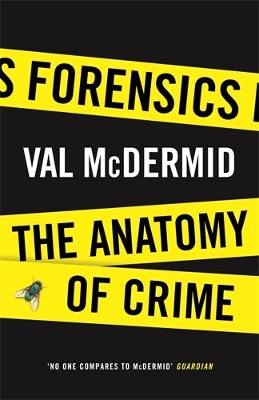
The dead talk. To the right listener, they tell us all about themselves: where they came from, how they lived, how they died - and who killed them. Forensic scientists can unlock the mysteries of the past and help justice to be done using the messages left by a corpse, a crime scene or the faintest of human traces.
Forensics uncovers the secrets of forensic medicine, drawing on interviews with top-level professionals, ground-breaking research and Val McDermid's own experience to lay bare the secrets of this fascinating science. And, along the way, she wonders at how maggots collected from a corpse can help determine time of death, how a DNA trace a millionth the size of a grain of salt can be used to convict a killer and how a team of young Argentine scientists led by a maverick American anthropologist uncovered the victims of a genocide.
In her crime novels, Val McDermid has been solving complex crimes and confronting unimaginable evil for years. Now, she's looking at the people who do it for real, and real crime scenes. It's a journey that will take her to war zones, fire scenes and autopsy suites, and bring her into contact with extraordinary bravery and wickedness, as she traces the history of forensics from its earliest beginnings to the cutting-edge science of the modern day.
Published in partnership with the Wellcome Collection.
WELLCOME COLLECTION is the free museum and library for the incurably curious. It explores the connections between medicine, life and art in the past, present and future. It is part of Wellcome, a global charitable foundation that exists to improve health for everyone by helping great ideas thrive.
I have so many thoughts about this book and they're scattered all over the joint.
It occurred to me as I finally finished reading it that we sometimes come at books in much the same way faulty investigators come at a crime scene: we take in the initial information (in our case, the title, cover and jacket flap) and make assumptions as to how the book is going to play out. If, as we start to read the book, it fails to fulfil our assumptions, we tend to then judge it on its failure to be what thought it would be, instead of judging it on what it is.
The differences between investigating crimes and reading books are ... obvious and profound, but in the case of books, the blame lies squarely on poor marketing. This book, for instance, has had two titles. It's original on release was Forensics: Anatomy of a Crime (the edition I have) and then upon reprinting, it was named Forensics: What Bugs, Burns, Prints, DNA and More Tell Us About Crime. It's former title is problematic, but not misleading. Those that choose the book based on the latter I think are bound for disappointment, unless they know absolutely nothing about forensics, have only a general interest in it, and very little curiosity about the actual science involved.
I wanted the science. I expected the science. I wasn't expecting the very journalistic style of the narrative. That part is on me, because I've never before read McDermid and didn't know about her background in journalism. I really dislike the style of writing journalists do; in too many cases the narrative ends up with a sensationalist tone that feels manipulative and turns me off. This book started off that way and had it not been for reassurances by friends that it would get better, I doubt I'd have continued reading it.
Thankfully, I found the remaining chapters more palatable, and once I re-adjusted my expectations (i.e. this is not a science book) I was able to more or less find something interesting in each. I also was left wanting though, too; she mentions the science, but never how it's done. She doesn't explain why polymerase enzyme would make DNA 'replicate the hell out of itself', or how forensics scientists lift fingerprints from seemingly impossible places. And I really had a problem with some statistics she included in the chapter on blood spatter/DNA, concerning the number of African-descent males in the UK vs US databases. I'm not objecting to the veracity of it, but the writing in that section was so badly done that at first glance, it appears she's using her words to skew the reader's perception. It took my husband and I 5 minutes of reading it and re-reading it before we decided it was probably just very terrible editing.
But there were lots of interesting bits too; with the right expectations, this would not be a wasted or disappointing read. For those with an interest in true crime and history, this book might be a winner. It's easy reading, the crimes she chooses are interesting (when they aren't horrific) and the book rarely drags.
At the end of the day, Forensics and the author would have been better served had they stuck with Anatomy of a Crime as a subtitle and marketed it as General Interest / True Crime*. As such, I think it would have a found a very appreciative audience. As it is, marketing it as a Popular Science book is setting everyone up for disappointment.
*Oddly enough, the publisher did list the subject as "True Crime", but then proceeded to use the back cover / page flap to sell the book as using "ground-breaking research" to "lay bare the secrets of this fascinating science".
And finally, my husband asked that I include his complete annoyance with the flies printed on all the pages of the book; he didn't read it, but every time he saw me with it, he'd catch a glimpse of the flies and think I'd squashed one between the pages. If they insisted on persevering with that theme, at least vary the squashed insects...
Reading updates
-
Started reading
-
13 November, 2017:
Finished reading
-
13 November, 2017:
Reviewed
